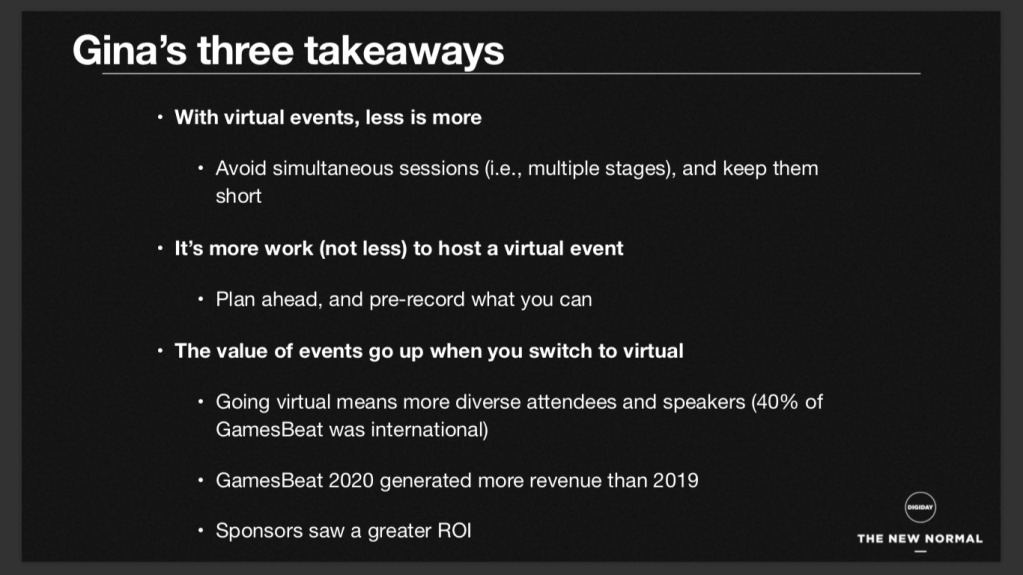‘Virtual events can be more valuable’: How VentureBeat kept sponsorship revenue on par with in-person events

The New Normal, was a weekly interactive show focused on how publishers are adapting their businesses during the onset of the COVID-19 pandemic. More from the series →
Tech publisher VentureBeat found itself in a situation familiar to many publishers with events businesses at the beginning of April.
The company’s annual GameBeat Summit 2020 was set to take place at the end of the month in Los Angeles and as the pandemic grew more severe, more and more precautions were put in place to keep guests safe. Eventually, however, it became illegal to hold events at all and just three weeks ahead of showtime, vp of strategic partnerships Gina Joseph said her team started adapting the event to be entirely virtual.
With 50% of the company’s revenue coming from events, Joseph said that events in their virtual form are still a significant part of the business strategy.
Joseph said that not only was her team able to hang onto all of the more than 120 speakers and keep the more than 50 sessions on the schedule for GameBeat, but all of the sponsors stayed locked in as well. The sales team was even able to sign additional partnerships leading up to the summit.
GameBeat Summit 2020 ended up bringing in more money from its virtual iteration than it did as its in-person version in 2019, she said. This was not only due to a higher profit margin, but also due to the fact that her team was able to keep sponsorships prices consistent with the summit’s original in-person format.
The summit’s success “proved out that virtual events can be more effective and valuable than in-person events,” Joseph said.
In the latest episode of The New Normal, Joseph talked about transitioning into virtual events and how lead generation and thought leadership are top of mind for the business-to-business publisher’s sponsors.
Serving marketers thought leadership opportunities
Joseph said that 90% of VentureBeat’s sponsors have thought leadership as a top objective when spending with the site. So the company created its custom content studio VB Lab in order to provide options for marketers’ campaigns. Since launching the lab last year, she said brand partnerships have increased 400% year-over-year and event partnerships have increased by 150% year over year.
VentureBeat’s audience is relatively small at 6 million monthly unique visitors, but Joseph said that marketers do not want to reach a massive audience through the site. “It’s a focus play and I think that is where the opportunity is,” she said. Targeted partnerships are what’s appealing to partners, she said.
The B2B space is all about lead generation
The first phase of marketing strategies is “always going to be thought leadership, awareness and going to market, and the more effective you can be in that,” the more quality leads you can get, Joseph said. In person events have always been a major tool for business-to-business marketers to achieve lead generation and provide touch points with their audience for marketers.
But, Joseph said, the fact of the matter is that in a virtual format there are more ways to track the impressions that sponsors made on the audience. In-person events have less tangible ways to estimate the number of people who saw a sponsor’s banner or the number of conversations that can be held by their booth. The virtual format gives sponsors the opportunity to hold more one-to-one meetings and have access to Slack channels to have more direct and engaged lines of communication.
More effective and valuable than in-person events
Overhead costs associated with in-person events are considerable and include everything from the venue to the food and beverage to the AV. But Joseph said that while those costs don’t apply to virtual events, the time and labor investment putting them together is “actually a lot more work.”
Even still, the event yielded enough interest that they decided to expand the summit into a series, with another one taking place this fall. Sponsorship levels will not decrease for the new event either, she said.
Adding humanization to a digital world
In order to get people involved and interacting with the content and during the networking opportunities “it comes down to personalization,” said Joseph, adding that all of the attendees have to feel like they’re connected with each other as well as with the brand hosting the event and the sponsors who are there. They shouldn’t feel like they are trapped behind the screen, she said.
Be “thoughtful about what their days look like,” she said. To do this, her team began integrating breaks fo participants to leave their computer as well as networking chats or one-on-one meetings. Joseph said they will also actively reach out to attendees to get real-time input during the event.
More in Media

With Firefly Image 3, Adobe aims to integrate more AI tools for various apps
New tools let people make images in seconds, create image backgrounds, replacing parts of an image and use reference images to create with AI.

Publishers revamp their newsletter offerings to engage audiences amid threat of AI and declining referral traffic
Publishers like Axios, Eater, the Guardian, theSkimm and Snopes are either growing or revamping their newsletter offerings to engage audiences as a wave of generative AI advancements increases the need for original content and referral traffic declines push publishers to find alternative ways to reach readers.

The Guardian US is starting its pursuit of political ad dollars
The Guardian US is entering the race for political ad dollars.





